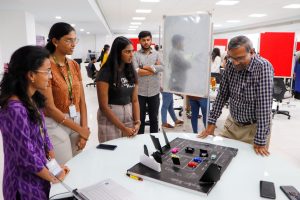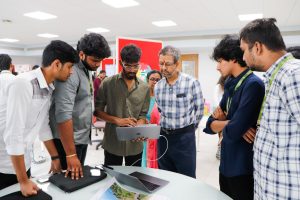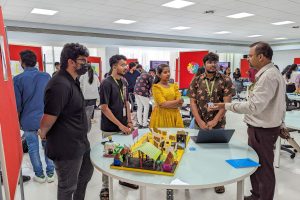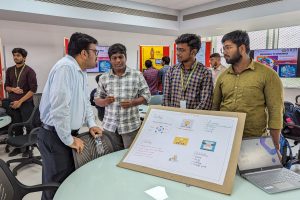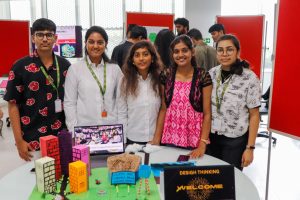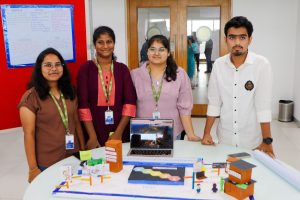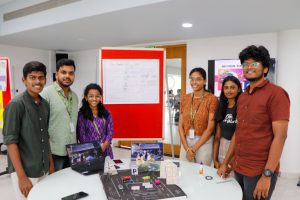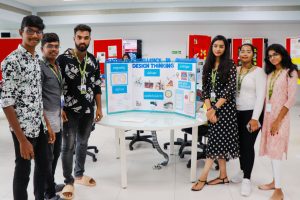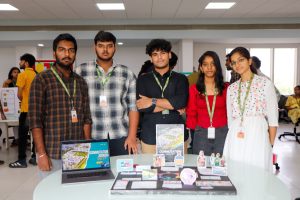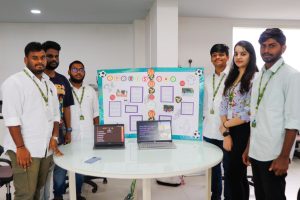Paper Presented at the NIAS Conference in Amsterdam
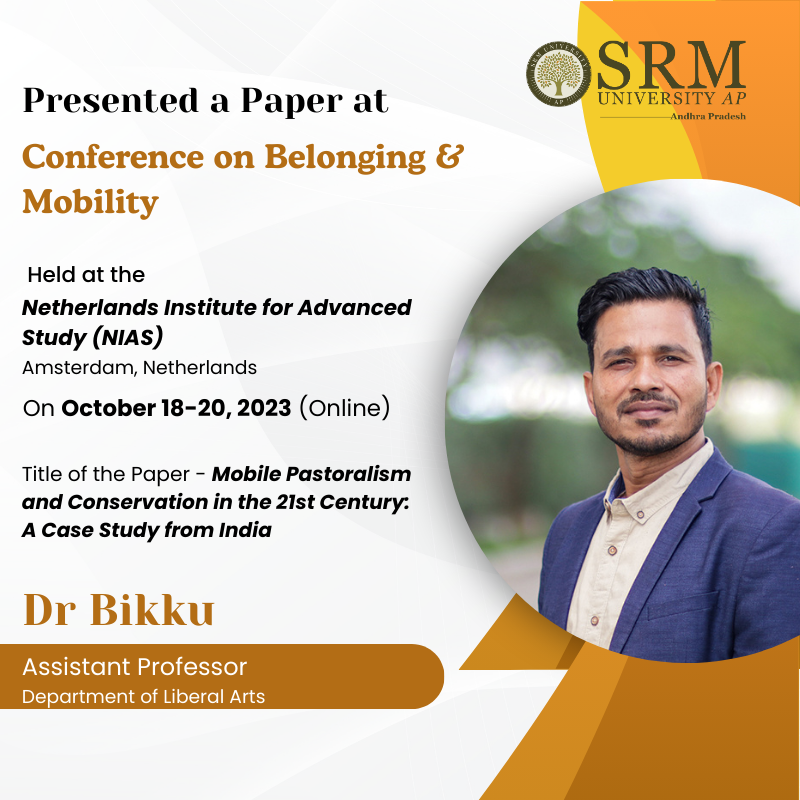
Dr Bikku, Assistant Professor, Department of Liberal Arts has presented a paper titled “Mobile Pastoralism and Conservation in the 21st Century: A Case Study from India” at the NIAS Conference on Belonging & Mobility, held at the Netherlands Institute for Advanced Study (NIAS), Amsterdam, Netherlands on October 18-20, 2023 (online).
Congratulations to Dr Bikku for this remarkable achievement. SRM AP immense pride in the success of its faculty and scholars and applauds their unwavering commitment to scientific excellence and societal impact!
Abstract
The study focuses on the struggle of nomadic pastoralists to continue their traditional occupation of raising livestock at different landscapes in the face of the shifting political ecology in India. Pastoralism is a traditional subsistence livelihood pattern that involves raising domestic animals in different pastures. For pastoralists to use continually shifting resources in a variety of ecological landscapes, mobility is an effective strategy. However, the current conservation approach has colonial roots and reinforces biodiversity conservation by establishing and enforcing protected areas in several countries around the globe. Scientific conservationists and states have often seen pastoralism responsible for environmental degradation and wildlife decline through over-grazing and resource competition, respectively. As a result, the customary rights of the various pastoralist groups have been denied inside and outside the protected areas.
The paper investigates the current global conflicts between pastoralism and conservation. It also emphasises the changing dimensions of mobile pastoralism and conservation policies in India. By challenging the conservationists’ and the state’s preconceived notions about pastoralism, the Raika mobile pastoralists of Rajasthan, India, provide sustainable pastoralism and nature conservation through evidence of the coexistence of pastoralism and multispecies.
- Published in Departmental News, Liberal Arts News, News, Research News
Using Nonlinear Differential Equations to Formulate a Novel Approach to Combat HIV-1
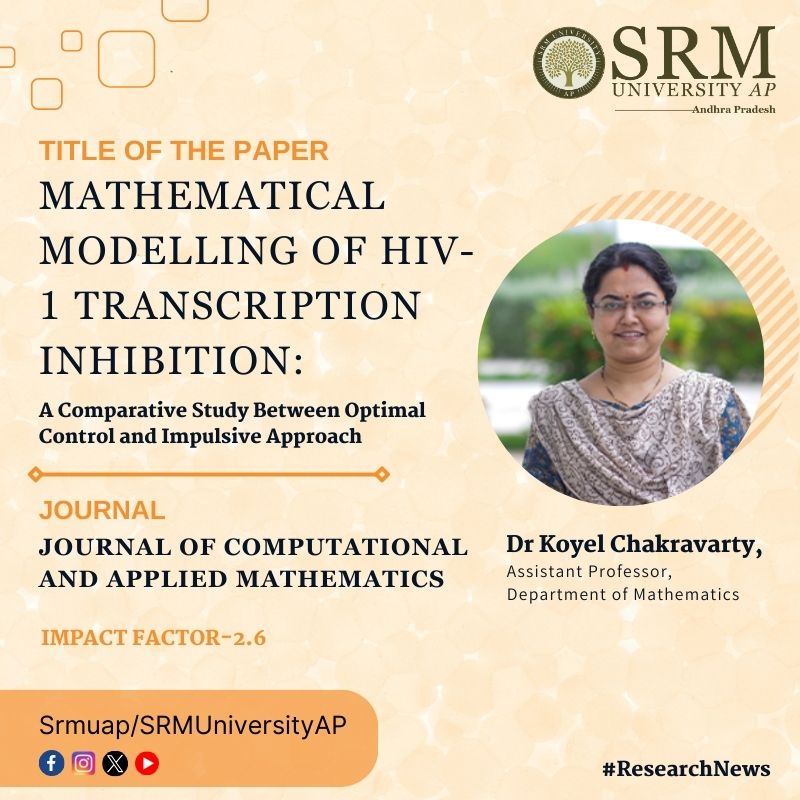
The combat against HIV, the virus responsible for AIDS has witnessed consistent advancements and studies put forward by researchers in various fields. To identify a more intelligent and effective approach to combat HIV-1 and enhance the understanding of the workings of its treatments, Dr Koyel Chakravarty, Assistant Professor, Department of Mathematics has published a paper titled “Mathematical modelling of HIV-1 transcription inhibition: a comparative study between optimal control and impulsive approach” in the Q2 journal, Journal of Computational and Applied Mathematics.
Abstract
By adopting a proactive strategy, this study facilitates the interaction with human immunodeficiency virus type I (HIV-1), successfully navigating its sequential fusion stages. This approach enables efficient infiltration of the virus into a target CD4+T helper cell within the host organism, initiating the virus’s replication cycle. As a retrovirus, HIV-1 orchestrates the conversion of its single-stranded viral RNA genome into a more stable double-stranded DNA structure. The newly formed DNA integrates with the host cell’s genetic material, and the pro-viral DNA transforms into functional messenger RNA (mRNA) with the assistance of the host enzyme RNA polymerase II (Pol II).
The ongoing research focuses on constructing a meticulous mathematical framework using a system of nonlinear differential equations. The investigation aims to assess the impact of a Tat inhibitor on suppressing the transcriptional activity of HIV-1, treating it as an optimal control problem. The study also evaluates the Tat inhibitor’s efficacy as a potential therapeutic intervention for HIV-1 infection. Employing a one-dimensional impulsive differential equation model to determine the mathematically derived maximum concentration of the elongating complex (P2), the research considers the crucial aspect of optimal timing between successive dosages. A comparative analysis contrasts the effects of continuous dosing with impulse dosing of the Tat inhibitor, using numerical analysis to evaluate outcomes. The findings underscore the superior effectiveness of impulsive dosing over continuous dosing in inhibiting HIV-1 transcription. Visual representations of the model’s parameter sensitivities enhance understanding of the intricate physiological and biochemical processes within the system.
Practical implementation/social implications of the research
1. Treatment Optimization:
• Practical Implementation: Develop personalized treatment plans for individuals with HIV-1 based on the optimal control and impulsive approaches identified in the study.
• Social Implication: Improve the effectiveness of HIV-1 treatments, potentially leading to better health outcomes and a higher quality of life for individuals living with the virus.
2. Drug Administration Guidelines:
• Practical Implementation: Provide guidelines for healthcare professionals on the timing and dosage of Tat inhibitors using insights from the comparative study.
• Social Implication: Enhance the efficiency of drug administration, potentially reducing side effects and improving patient adherence to treatment regimens.
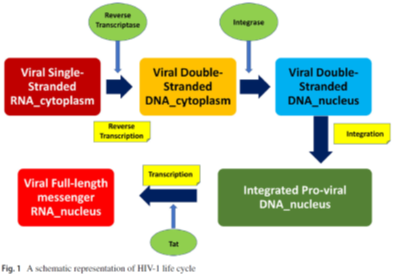
3. Public Health Planning:
• Practical Implementation: Incorporate the study’s findings into public health planning, considering the optimal and impulsive control strategies in broader HIV-1 prevention and treatment programs.
• Social Implication: Contribute to more effective and resource-efficient public health interventions, potentially reducing the overall burden of HIV-1 in communities.
4. Drug Development Strategies:
• Practical Implementation: Inform pharmaceutical companies and researchers about the comparative study results to guide the development of new HIV-1 inhibitors or improvements to existing drugs.
• Social Implication: Accelerate the development of more potent and targeted therapies, offering new options for managing HIV-1 infections.
5. Patient Education:
• Practical Implementation: Develop educational materials for individuals with HIV-1, explaining the importance of adherence to optimized treatment plans based on the study’s findings.
• Social Implication: Empower patients to actively participate in their treatment, potentially leading to better treatment outcomes and reduced transmission rates.
6. Policy Recommendations:
• Practical Implementation: Present policy recommendations to healthcare institutions and government agencies based on the study’s outcomes.
• Social Implication: Influence health policies to integrate the most effective strategies for HIV-1 transcription inhibition, potentially contributing to more efficient resource allocation and improved public health outcomes.
7. Global Health Impact:
• Practical Implementation: Collaborate with international health organizations to disseminate the study’s findings globally.
• Social Implication: Contribute to global efforts in controlling the HIV-1 pandemic, fostering collaboration and knowledge-sharing among nations.
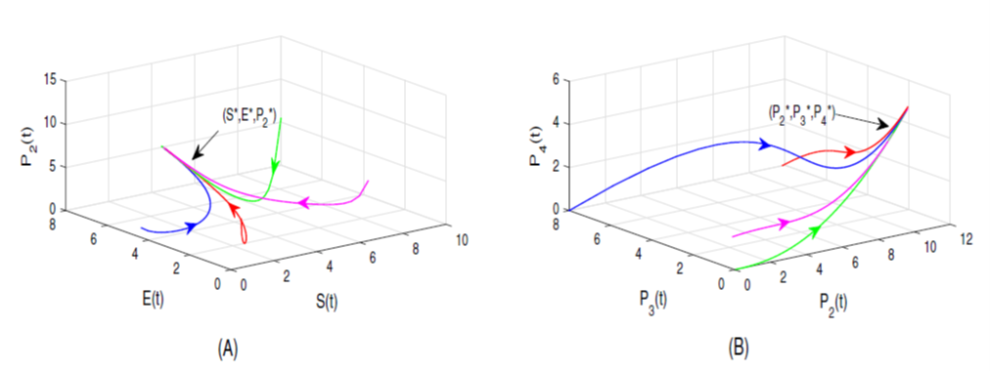
8. Reduced Healthcare Costs:
• Practical Implementation: If the impulsive approach proves more cost-effective, healthcare systems can implement this strategy to potentially reduce the overall cost of HIV-1 treatment
• Social Implication: Alleviate financial burdens on both individuals and healthcare systems, making HIV-1 treatment more accessible
In summary, the practical implementation and social implications of this study extend from optimizing individual treatment plans to influencing global health policies, ultimately contributing to more effective HIV-1 management and improved public health outcomes.
Collaborations
- Prof. D C Dalal, Professor, Department of Mathematics, IIT Guwahati
- Prof. A K Sarkar, Professor, Centre for Mathematical Biology and Ecology, Department of Mathematics, Jadavpur University
- Dr L N Guin, Associate Professor, Department of Mathematics, Visva-Bharati
Future Prospects of the Research
- Mathematical Modelling of Cholesterol Dynamics.
- Mathematical Modelling of Muscle Regeneration.
- Mathematical Modelling of Bone Remodelling
- Mathematical Modelling of Glucose-Insulin Dynamics.
- Mathematical Modelling on HIV-1 Transcription.
- Mathematical Modelling of Population Dynamics for Patients suffering from Diabetes.
- Published in Departmental News, Math News, News, Research News
Intellectual realm of Vaishnava Philosophy and Poetic Aesthetics
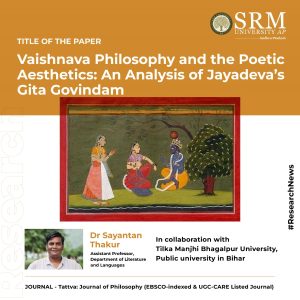 Dr Sayantan Thakur, Assistant Professor in the Department of Literature & Languages have published his research paper, ‘Vaishnava Philosophy and the Poetic Aesthetics: An Analysis of Jayadeva’s Gita Govindam‘ in Tattva: Journal of Philosophy, an esteemed EBSCO-indexed and UGC-CARE Listed Journal. Dr Thakur’s work embodies the spirit of academic rigor and philosophical inquiry. Join us in traversing the landscapes of wisdom, where intellect meets aesthetics, and knowledge transcends boundaries. Explore the rich tapestry of ideas that define SRM University-AP‘s commitment to intellectual excellence.
Dr Sayantan Thakur, Assistant Professor in the Department of Literature & Languages have published his research paper, ‘Vaishnava Philosophy and the Poetic Aesthetics: An Analysis of Jayadeva’s Gita Govindam‘ in Tattva: Journal of Philosophy, an esteemed EBSCO-indexed and UGC-CARE Listed Journal. Dr Thakur’s work embodies the spirit of academic rigor and philosophical inquiry. Join us in traversing the landscapes of wisdom, where intellect meets aesthetics, and knowledge transcends boundaries. Explore the rich tapestry of ideas that define SRM University-AP‘s commitment to intellectual excellence.
Abstract
Literature finds the best expression when literary aesthetics and philosophy run side by side. The former offers the external charm, while the latter inculcates the more profound implication with the aim of providing it with a superior stature and permanence. Jayadeva’s Gitagovindam, being a colossal work in the field of Vaishnava literature, does contain the brilliant juxtaposition of both. This article attempts to show how Jayadeva’s Gitagovindam, a colossal work in the field of Vaishnava literature, does contain the brilliant juxtaposition of both. On the one hand, like a typical lyrical poem, its melodic nature does have a soothing effect and on the other, the use of philosophy instils in it a greater depth and seriousness to uplift itself as a book of devotion and religious inspiration. Moreover, the importance of this Holy Scripture lies in the fact that it not only played a significant role in paving the way to form a new sect in the Vaishnava religion, known as ‘Gaudiya Vaishnavism’, but also showed the later Vaishnava lyricists the art of portraying in words the amorous love of Lord Krishna and Radha with compassion and tears.
Practical implementation and social implications of the research
Cultural Preservation: Understanding and analysing ancient texts like the Gitagovindam helps in preserving cultural and religious heritage. This research can contribute to the preservation and understanding of Vaishnava philosophy and its cultural significance.
Literary Understanding: Analysis of the text can provide insights into the interplay between philosophy and aesthetics in literature. It can be used as a tool for students, scholars, and enthusiasts to comprehend how profound thoughts are conveyed through art and literature.
Religious Studies: It will be valuable for religious scholars and practitioners, shedding light on the philosophical underpinnings of Vaishnavism. It can deepen the understanding of the religious sentiments associated with the worship of Lord Krishna.
Artistic Inspiration: By examining the poetic aesthetics the research might inspire contemporary artists, poets, and musicians in exploring similar thematic elements in their creations. It could lead to the creation of new artistic works that incorporate similar philosophical depth.
Community Understanding: Studies like mine can also bridge gaps in understanding between different communities by shedding light on the beliefs and values encapsulated in ancient texts. This understanding might foster better cultural appreciation and harmony.
Interdisciplinary Insights: The analysis might encourage interdisciplinary studies by merging literary analysis with philosophy, offering new avenues for exploration and collaboration between these fields.
Collaborations
Dr. Uday Kumar Mishra, Professor, Department of English, TMBU
Future Research Plans
- Regional Literature in Translation
- Tantric Tradition and Eastern Indian Literature,
- Folk Music of Bengal,
- Indian Philosophy, Aesthetics & Literature
Link to the Article
https://journals.christuniversity.in/index.php/tattva/article/view/3640/2480
- Published in Departmental News, English Current Happenings, News, Research News
Lecture on Marginalised Childhoods
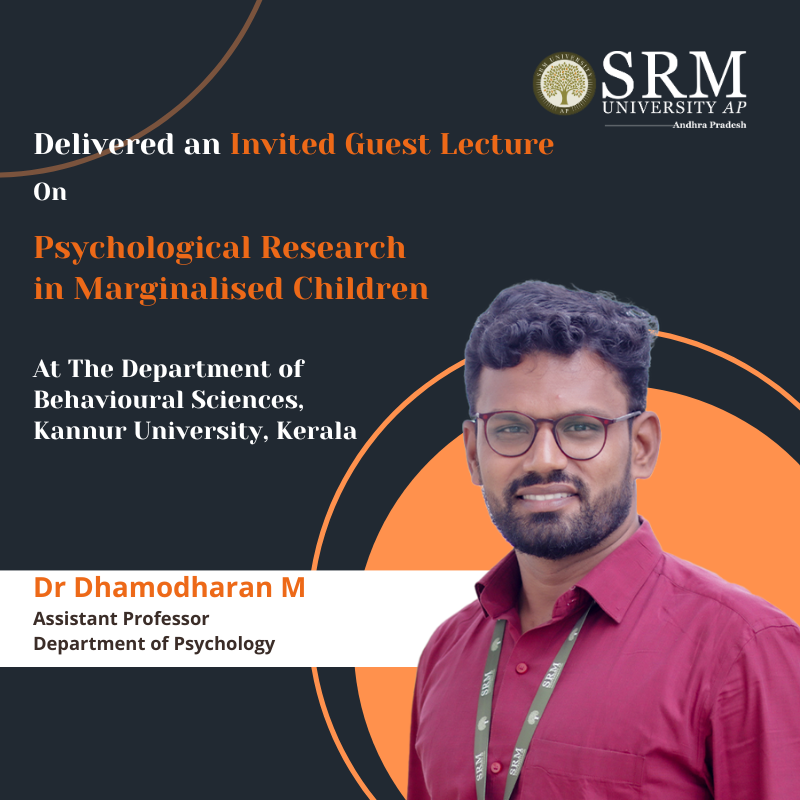
In an insightful talk at the Department of Behavioural Sciences in Kannur University, Dr Dhamodharan M, Assistant Professor at the Department of Psychology, SRM University-AP, shed light on “Psychological Research in Marginalized Children.” Dr Dhamodharan’s talk serves as a call to action, encouraging a deeper exploration of psychological research for the betterment of future generations.
Here’s an abstract of Dr Dhamodharan’s riveting talk.
Abstract
The invited lecture mainly focuses on the status and importance of psychological research in marginalized children. Marginalized People who are excluded from majority social, economic, educational, and/or cultural life. They are excluded due to race, gender identity, sexual orientation, age, physical ability, language, and/or immigration status (Baah et al.,2019). The term marginalized children include Children affected by or emerging from armed conflict or humanitarian crises, Children with disabilities, Children in remote or rural areas (including those who lack access to safe water and sanitation), Religious or ethnic minorities, Orphans, and children affected by HIV/AIDS, Child laborers, Married Children, Victims of trafficking (Legal Information Institute,2023). The World Health Organization defined “Child maltreatment is the abuse and neglect that occurs to children under 18 years of age. It includes all types of physical and emotional ill-treatment, sexual abuse, neglect, negligence, and commercial or other exploitation, which results in actual or potential harm to the child’s health, survival, development, or dignity in the context of a relationship of responsibility, trust or power” (World Health Organization, 2020). Children need essential nutrition, parental care, education, safety, entertainment, medical assistance, and physical, psychological, and social development (Deb & Ray, 2015). Children have their first human contact at home in a pleasant, nurturing, and caring environment; unfortunately, home is also where children are exposed to violence for the first time (United Nations Children’s Fund,2017). All children have the right to be safe from violence, oppression, and abuse. Despite this, globally, millions of children from all socioeconomic backgrounds, religions, cultures, and ages are subjected to violence and abuse daily. Violence against children is typical and endemic, and it is a terrible reality for millions of Indian children.
Over half of the world’s children have been subjected to extreme violence, with South Asia representing 64% of these instances (End Violence against Children | UNICEF India, n.d.) All types of violence against persons under 18 are considered violence against children. In 2019, about 1 billion children under eighteen experienced physical, sexual, or emotional violence or neglect globally (WHO, 2020). In the world, 3 out of 4 children aged 2-4 years were subjected to violent regulation from caregivers daily. Six out of ten children were exposed to physical punishment, one out of every two children aged 2 to 17 experienced some type of violence, and 18% of girl children experienced childhood sexual violence, while 8% of boys experienced the same (UNICEF, 2020; United Nations Children’s Fund, 2017). Victims of child abuse have also been exposed to more than one type of violence (Descartes et al., 2020).
Many countries are not prohibited corporal punishment. One in every two children aged 6 to 17 is subjected to corporal punishment. Around fifteen million girls aged 15 to 19 have been subjected to forced sex from partners, boyfriends, or husbands, with just one percent seeking professional help. Throughout the world, 1 in every three children aged 13 to 15 has experienced bullying at school. Girls face more psychological bullying than boys, whereas boys face more physical bullying than girls (UNICEF, 2020. Sexual assault and exploitation are the most common violence in slum regions. Those in positions of supremacy and authority, such as educators and leaders, are the primary perpetrators. Early pregnancy is also a serious concern among the underprivileged community, which leads to sexual exploitation (Nagasurendran, 2017).
Approximately 70 lakh children in India are not receiving all vaccinations, particularly in slum areas, migrant settlement areas such as fisher villages, construction sites, and inaccessible villages. This data is very high compared to all other countries globally. Proper childhood nutrition is a significant indicator of development and welfare, especially in developing countries. However, previous literature studies failed to focus on the children from the marginalized communities. The students from Psychology background need to explore the marginalized children’s health, education, and mental health. Furthermore, the marginalized children study findings would be an eye-opener for the social welfare department to take need-based welfare measures for marginalized children.
Current Status of Research
- Convenience sampling procedures overrepresent dominant groups (Rad et al., 2018)
- Only 5% of articles in one premier psychology journal predominately sampled ethnic minorities (Thalmayer et al., 2020)
- Less than 2% of psychological studies across three decades of research included sexual minorities as participants (Lee & Crawford, 2021)
Major Challenges faced by Marginalisation Children
- Health Issues – Malnutrition, Lack of healthcare facilities
- Lack of Educational Support
- Abuse and Violence
- Lack of Social Support
- Caste Discrimination
Areas to Study in Marginalization Children
- Discrimination in School and Community (Deb, 2019)
- Resilience and coping mechanisms (Dar,2020)
- Educational motivation and Teacher-student relationships (Martin,2020)
- Traumatic and Post Traumatic Stress (Szota,2023)
- Identity Formation (Yosef,2023)
- Social Support and Media Influence (Kaskazi,2023)
- Published in Departmental News, News, Psychology News
A Novel IRS-relay Network for ITS with Nakagami-m Fading Channels
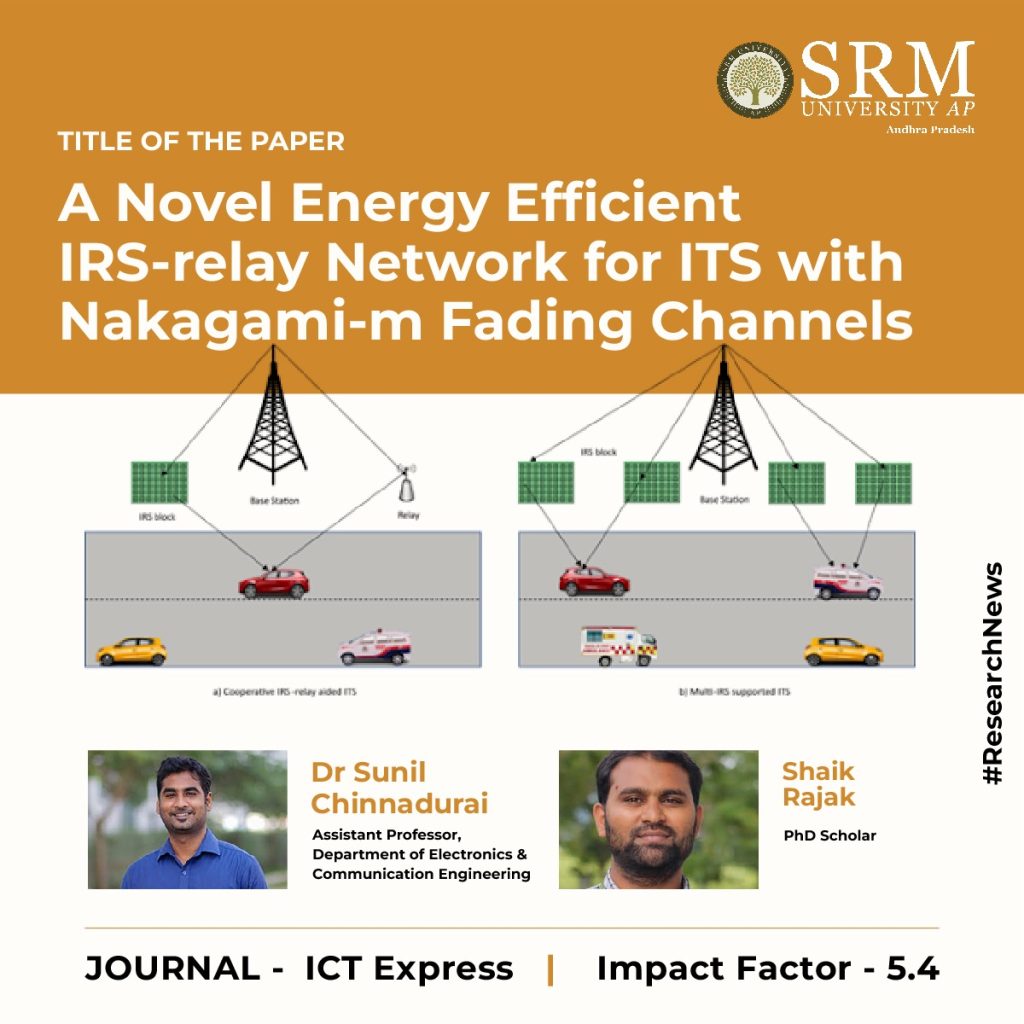
The Department of Electronics and Communication Engineering is proud to announce the publication of a research paper by Dr Sunil Chinnadurai, Assistant Professor and Research scholar Shaik Rajak titled “Novel Energy Efficient IRS-relay Network for ITS with Nakagami-m Fading Channels” in the Q1 journal ICT Express, having an Impact Factor of 5.4. The paper focused on developing an energy-efficient network for ITS that utilises Nakagami-m fading channels to improve communication reliability and efficiency.
In this work, the research duo introduced a cooperative system involving relay technology and an IRS (Intelligent Reflective Surface) with passive elements. Evaluating energy efficiency and achievable rates, they found that the cooperative relay-IRS system outperformed individual relay and IRS setups. The study also compared multi-IRS setups, highlighting their effectiveness in reducing power consumption and deployment costs for improved ITS development.
Abstract
The research paper investigates the performance of energy efficiency (EE) for Intelligent Transportation Systems (ITS) using a cooperative IRS-relay network. The proposed cooperative IRS-relay-aided ITS network integrates an IRS block with a number of passive reflective elements to improve EE. The research analyses the ITS in terms of EE and achievable rate under Nakagami-m fading channel conditions. The research aims to reduce power consumption over long distances and operate the system faster and safer.
Practical implementation/ social implications of the research
The proposed cooperative IRS-relay network for Intelligent Transportation Systems (ITS) has practical implications for improving energy efficiency and achieving higher data rates in ITS networks. Integrating an IRS block with passive reflective elements in the relay model enhances the coverage area and reduces power consumption in ITS. The research highlights the significance of cooperative IRS-relay and multi-IRS-aided networks in the development of ITS, which can contribute to safer and faster transportation.
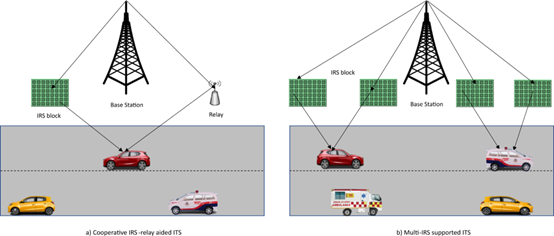
Dr Chinnadurai and Mr Rajak Future will continue to work on their research focusing on optimizing the design of the cooperative IRS-relay network for ITS to improve energy efficiency and achievable data rates further in real-world scenarios.
- Published in Departmental News, ECE NEWS, News, Research News
Physics Duo Publish in Prestigious Journal
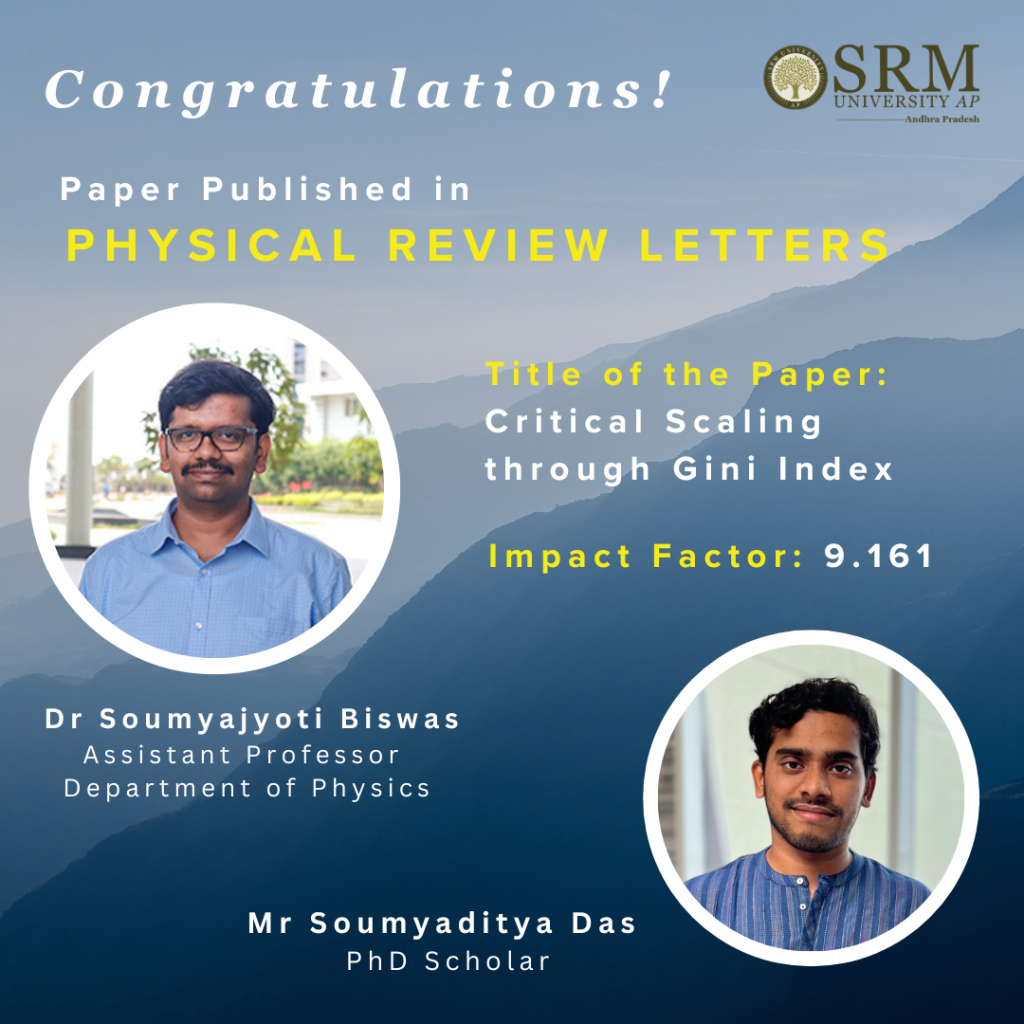
Dr Soumyajyoti Biswas, Assistant Professor in the Department of Physics, along with his Doctoral Scholar, Mr Soumyaditya Das, have presented groundbreaking findings through their research work titled “Critical Scaling through Gini Index”. The research paper was featured in the prestigious Physical Review Letters, which has an impact factor of 9.161.
Abstract
In the systems showing critical behaviour, various response functions have a singularity at the critical point. Therefore, as the driving field is tuned toward its critical value, the response functions change drastically, typically diverging with universal critical exponents. In this Letter, we quantify the inequality of response functions with measures traditionally used in economics, namely by constructing a Lorenz curve and calculating the corresponding Gini index. The scaling of such a response function, when written in terms of the Gini index, shows singularity at a point that is at least as universal as the corresponding critical exponent. The critical scaling, therefore, becomes a single parameter fit, which is a considerable simplification from the usual form where the critical point and critical exponents are independent. We also show that another measure of inequality, the Kolkata index, crosses the Gini index at a point just prior to the critical point. Therefore, monitoring these two inequality indices for a system where the critical point is not known can produce a precursory signal for imminent criticality. This could be useful in many systems, including condensed matter, bio- and geophysics to atmospheric physics. The generality and numerical validity of the calculations are shown with the Monte Carlo simulations of the two-dimensional Ising model, site percolation on the square lattice, and the fibre bundle model of fracture.

Fig.1: Shows the crossing point of the Gini index and the Kolkata index prior to critical point for three different models (from left Ising model in 2d, site percolation in 2d and fiber bundle model of fracture) form both side of critical point.
Collaborations and Future Plans
This work essentially builds a framework for indicating imminent critical points for any system. Therefore, in situations where such knowledge is vital, for example, in the fracture of solids, the method is going to be highly useful in forecasting the failure point. We are in the process of working with our collaborators at the University of Barcelona to experimentally verifying our methods for the compressive failure of porous samples. This is a significant first step towards opening new pathways in forecasting fracture points in disordered materials that could have an impact on laboratory-scale fractures to large constructions and eventually to earthquakes.
We wish the teacher-student duo many more fulfilling and enriching research endeavours in future!
- Published in Departmental News, News, Physics News, Research News
Utilising Social Media Platforms for Crisis Management
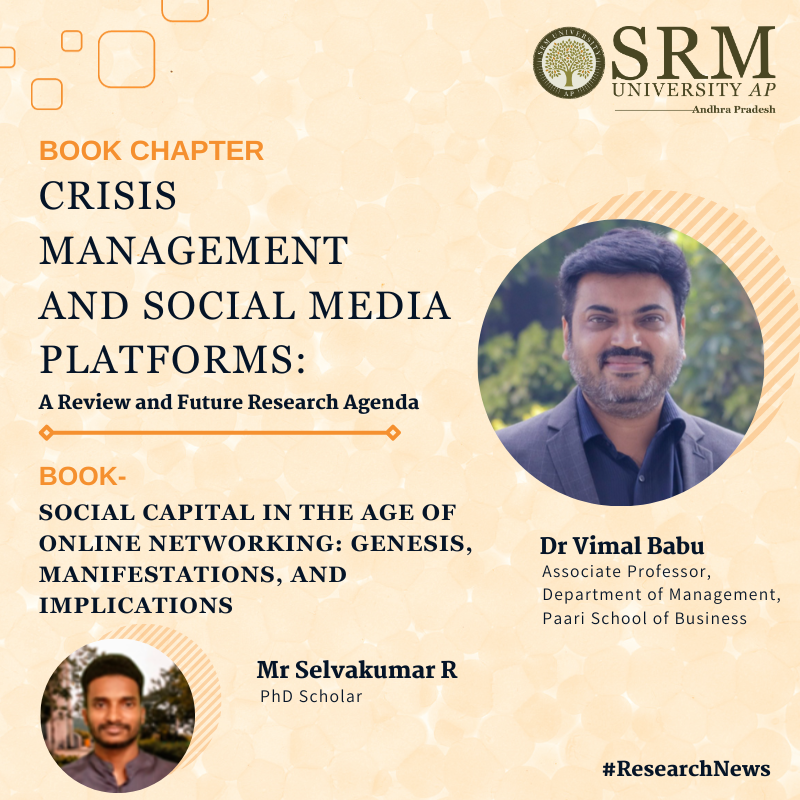
Dr Vimal Babu, Associate Professor and Mr Selvakumar R, Research Scholar from the Department of Management, Paari School of Business has published a fascinating book chapter titled “Crisis Management and Social Media Platforms: A Review and Future Research Agenda” in the book Social Capital in the Age of Online Networking: Genesis, Manifestations, and Implications examining their perspectives on the ever-changing digital ecosystem and its repercussions.
In this chapter, we research duo has made a concerted effort to advance the understanding of crisis management using social media platforms (Social networking sites). Crisis management encompasses a broader spectrum of crisis leadership, and utilising social media platforms (SMPs) for crisis management (CM) has become the modern approach to handling crisis events. Recognising the importance of exploring and advancing crisis leadership concepts to enhance the existing body of knowledge, his work is the first to employ a bibliometric approach to investigate this area, contributing to the nascent literature on the subject. The unique insights garnered from this analysis are expected to provide valuable guidance to researchers and scholars interested in this emerging field.
The book “Social Capital in the Age of Online Networking” digs into the fascinating growth of relationships and connections in the virtual sphere in a digital era when clicks matter as much as handshakes. This edited volume reveals the pattern of our modern networked society, linking theoretical ideas and real-world implementations. The book’s objective is to provide a comprehensive understanding of the current and prospective state of theory and applications of this phenomenon, and it will benefit researchers, government and private research institutions, business corporations, and students in various fields such as business, economics, information technology, psychology, medicine, and humanities.
- Published in Departmental News, News, Paari Current Happenings, Research News
Exploring the Dynamics of Democracy and Foreign Policy
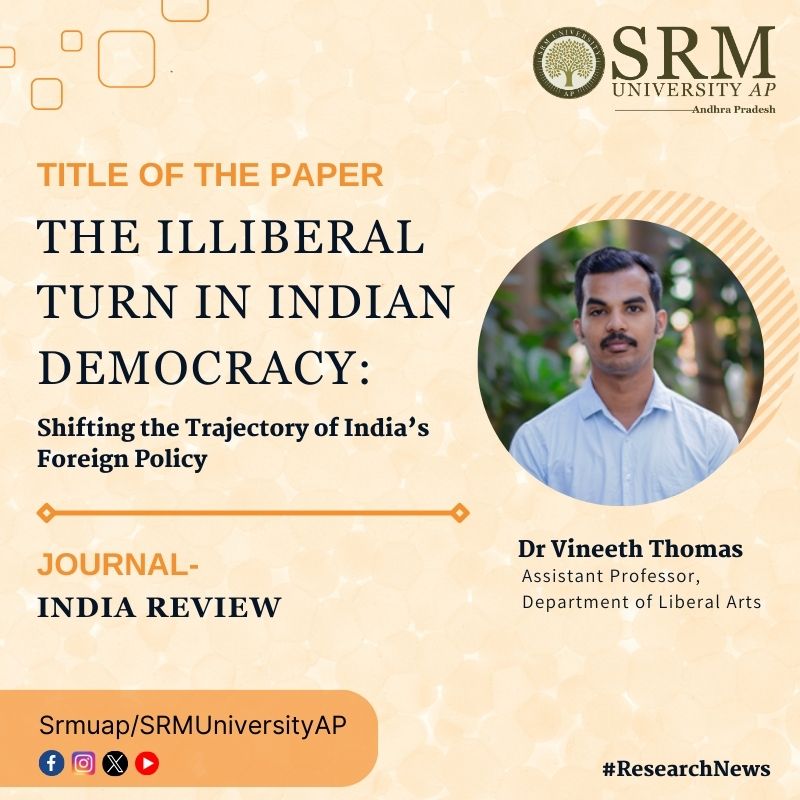
Dive into the intricate realms of Indian democracy and its ever-evolving foreign policy with a compelling research paper by Dr Vineeth Thomas, Assistant Professor, Department of Liberal Arts. The university is happy to announce the publication of Dr Thomas’ latest work, titled “The Illiberal Turn in Indian Democracy: Shifting the Trajectory of India’s Foreign Policy“, in the prestigious Q2 Journal “India Review“.
The paper is a profound exploration of the dynamic shifts in India’s foreign policy, drawing attention to the complexities of the nation’s democratic journey. His research delves into the nuanced interplay of domestic politics and global diplomacy, providing fresh perspectives on the illiberal turn in India’s democratic trajectory. The insightful work takes on a thought-provoking journey into the evolving facets of Indian democracy and the intricate interplay between domestic politics and foreign policy.
Abstract
Long-standing democracies such as India were not exempt from the global trend of democratic retreat. India has come under increasing international attention due to certain domestic policies such as the revocation of Article 370 of the Indian Constitution, the National Register of Citizens and Citizenship (Amendment) Act passed under the Bharatiya Janata Party government. In addition to India’s democratic decline being reflected in global democratic rankings, this has induced strains on India’s foreign relations. In its pursuit of becoming a leading power, India’s perceived democratic backsliding is likely to influence the direction of its foreign policy. To discern the impact of its perceived illiberal turn on its foreign engagement, the role of democracy in India’s foreign policy needs to be explored. While attempts have been made to understand democratic backsliding through a theoretical lens, the impact of a nation’s democratic status on its foreign relations and policy remains a largely unexplored area.
This study will help to understand how India’s democratic backsliding can induce a shift in its foreign policy.
- Published in Departmental News, Liberal Arts News, News, Research News
Exhibition on Design Thinking Projects
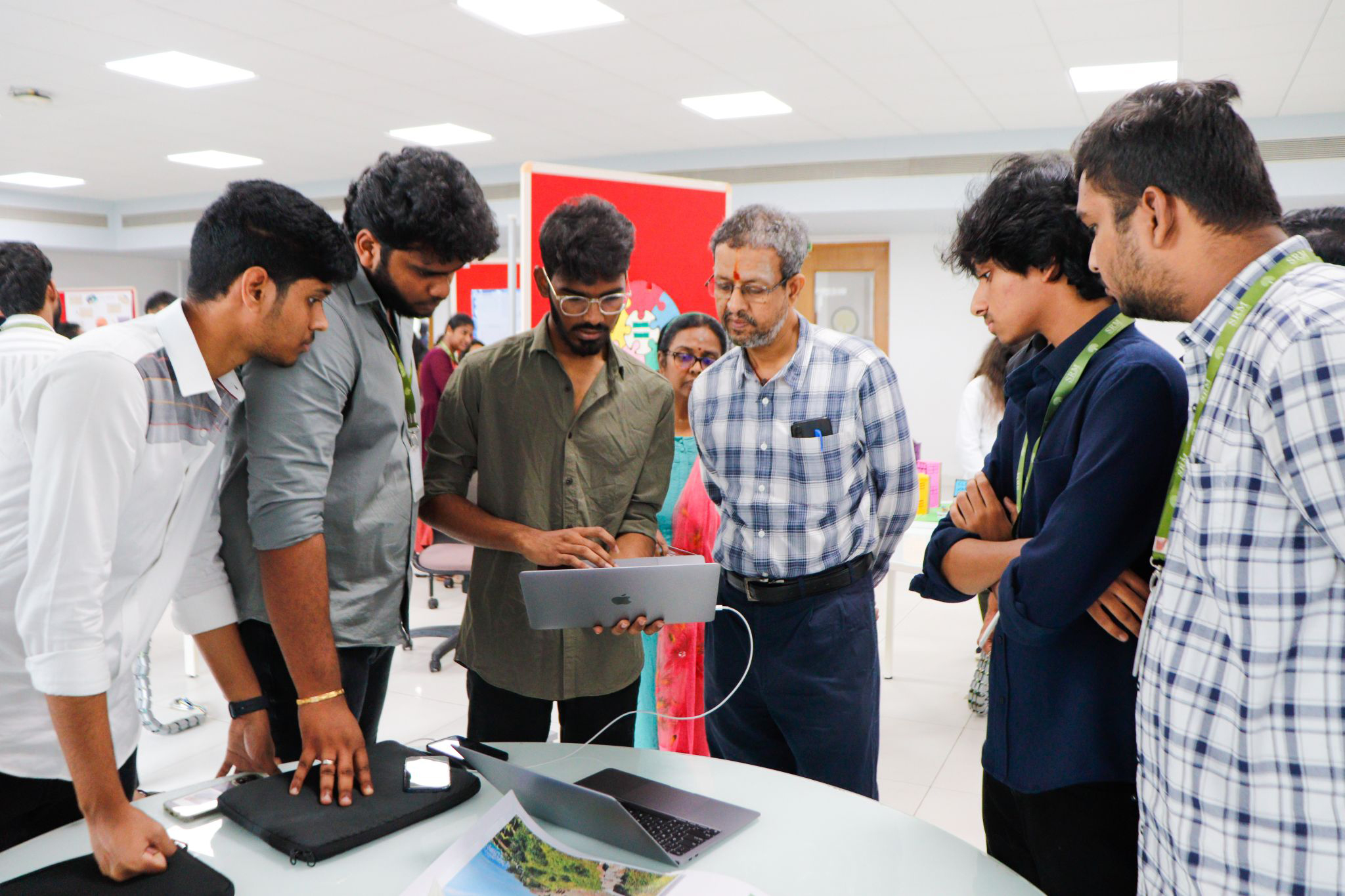
The Paari School of Business organised an exhibition on projects developed by students of the BBA (Hons) programme on the concepts of Design Thinking as a part of their course curriculum. Students exhibited their work to Dr Premkumar R, Registrar; Prof. Bharadhwaj Sivakumaran Dean; Dr Vimal Babu Ph.D. and Mr ARUN PRASAD GS, Faculty of Paari School of Business and students of the varsity.
The exhibition was a successful platform for students to display their knowledge and understanding of Design Thinking and have constructive discourse on this novel and innovative topic!
- Published in Departmental News, News, Paari Current Happenings
Research Fellowship from Humboldt University of Berlin
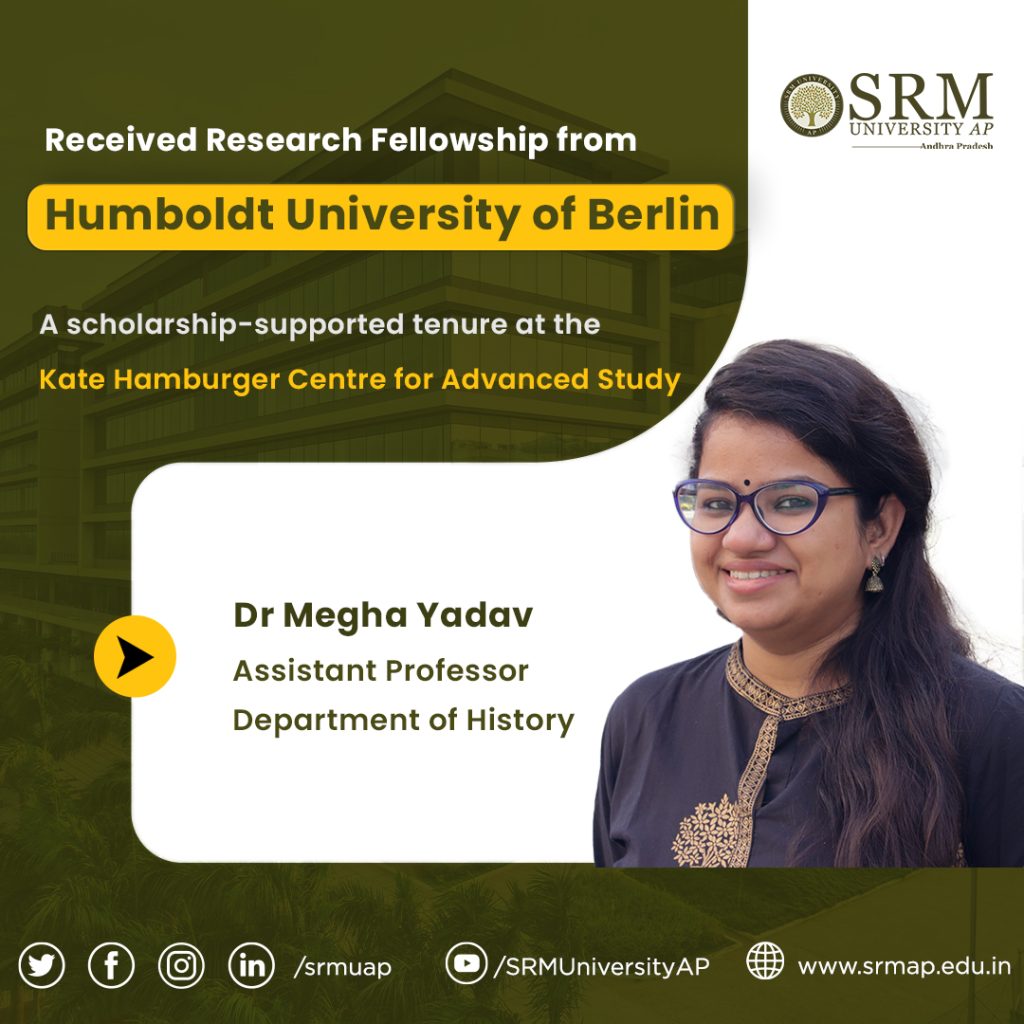
Dr Megha Yadav has received a prestigious fellowship from the Käte Hamburger Centre for Advanced Study, inherit.Heritage in Transformation, Humboldt Universität Zu Berlin, Germany. The fellowship allows for the undertaking of the research project, Visualising the Tradition, Preserving History: Material Practices in Tibetan Buddhism. This project takes an initiative to understand the ideas of heritage and history among the Tibetan Buddhist community by looking at the visual material and its heritage in Tibetan society to reach a nuanced picture of Tibetan history and heritage which keeps the Tibetan community at the centre of this understanding.
The project will attempt to understand the ways and methods of remembrance, preservation, and transmission of what Tibetan Buddhists consider to be their history. Most academic works have utilized Buddhist textual traditions to talk about Tibetan society, which has the inherent limitation of being one-dimensional. As a point of entry, this research will focus on thangka paintings as they create a very intimate window to people’s way of thinking about themselves, their universes, and their personal history. It was a ‘material’ to be showcased in public spaces, notably monasteries. It was meant for everyone to see, pay their respects, and take the image back with them in their minds and hearts. In a sense, these paintings were a showcase for the Tibetan Buddhist community.
This project will also pay attention to the changes brought about by 20th-century events, most notably colonization and the exile of the Dalai Lama and many Tibetans by inquiring into the changes brought into the idea and making of thangka paintings, raising questions about patronage, method, and content in the 20th century. An equally important intervention in the method and content of these paintings came with the spread of digital media platforms. While digital media has ‘democratised’ the making of thangka paintings, the question remains: what has it done to the process of making a thangka? How has the value associated with the paintings, as well as their making process, been changed by the technical medium? Has it impacted the content of these paintings? More importantly, what kind of changes have come into the community’s understanding of their past and present? These and any other issues that may come up during research will be addressed.
- Published in Departmental News, History Current Happenings, History News, News


